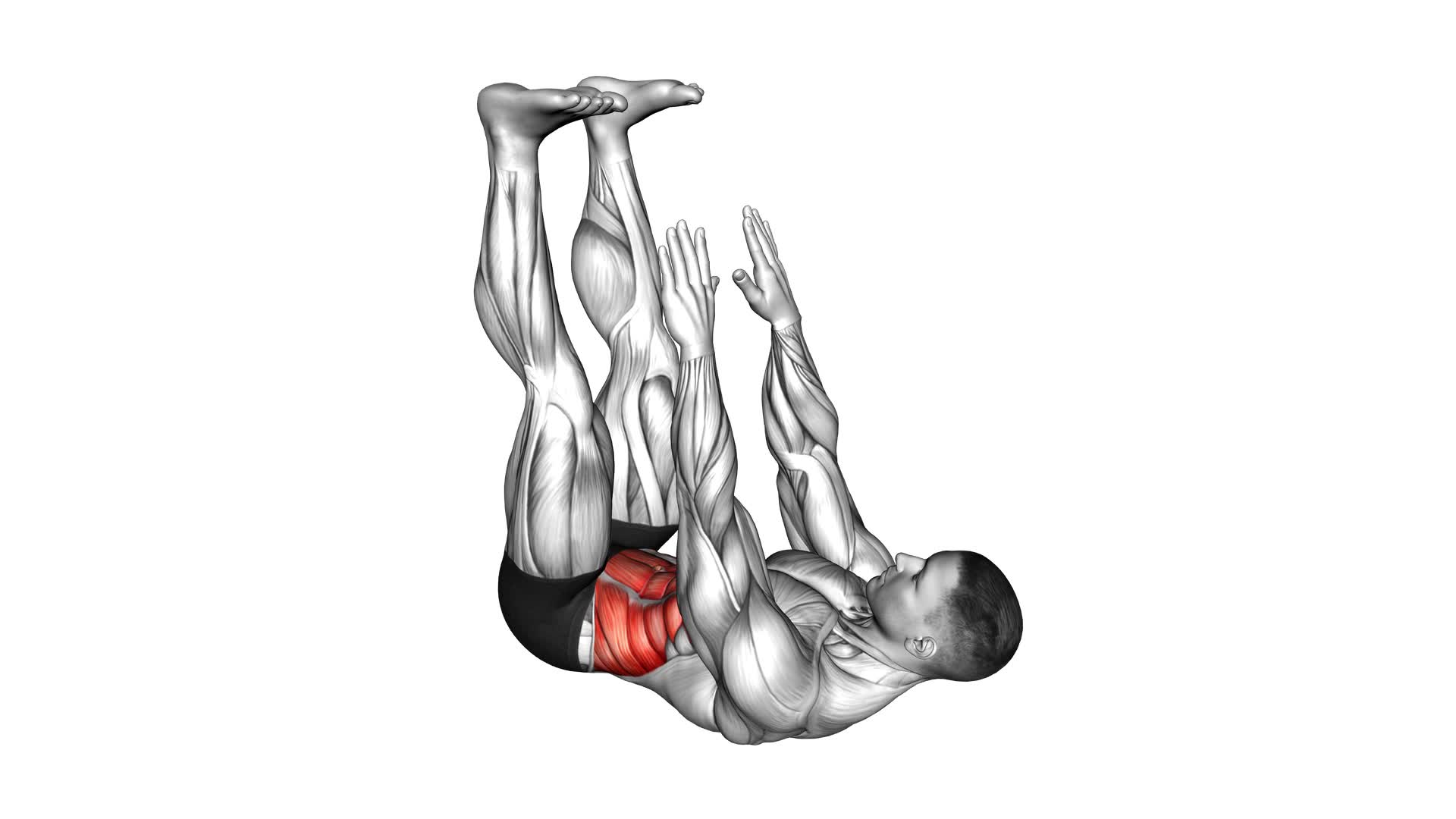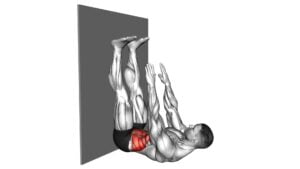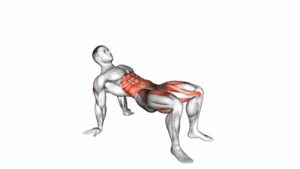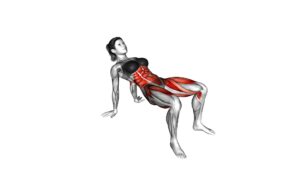Lying Twist Toe Touch – Video Exercise Guide & Tips

Are you looking for a new exercise to add to your routine? Look no further than the Lying Twist Toe Touch!
Watch This Exercise Video
This video exercise guide will show you the proper form and technique for this workout. Whether you're a beginner or advanced, there are modifications and progressions for all fitness levels.
Avoid common mistakes and maximize the effectiveness of this exercise with our helpful tips.
Get ready to feel the burn with the Lying Twist Toe Touch!
Key Takeaways
- The lying twist toe touch exercise improves core strength and increases flexibility in the spine, hips, and hamstrings.
- It targets abdominal muscles, obliques, and lower back, enhancing stability and balance.
- Proper form and technique include engaging the core, twisting from the waist, and avoiding straining the lower back.
- Using proper form not only maximizes the effectiveness of the exercise but also reduces the risk of injuries and lower back pain.
Benefits of the Lying Twist Toe Touch
Discover the numerous benefits of the Lying Twist Toe Touch for improving core strength and flexibility. This exercise is highly effective in targeting the muscles of the core, including the abdominals, obliques, and lower back. By engaging these muscles, you can enhance your overall stability and balance.
The Lying Twist Toe Touch also helps to improve flexibility in the spine, hips, and hamstrings. As you twist your torso and reach for your toes, you're stretching and lengthening these muscles, increasing their range of motion. This can be especially beneficial for individuals who experience tightness in these areas.
To maximize the benefits of this exercise, it's important to use proper techniques for improving flexibility in the lying twist toe touch. Start by engaging your core and keeping your back flat on the ground. As you twist, make sure to move from your waist, rather than your shoulders, to avoid straining your lower back.
To prevent lower back strain during the lying twist toe touch, it's essential to maintain proper form and listen to your body. If you feel any discomfort or pain in your lower back, modify the exercise by bending your knees or reducing the range of motion. It's always better to prioritize safety and avoid pushing yourself too hard.
Incorporating the Lying Twist Toe Touch into your workout routine can yield significant benefits for core strength and flexibility. By following proper techniques and listening to your body, you can safely enjoy the advantages of this exercise.
Proper Form and Technique for the Exercise
To ensure you perform the lying twist toe touch exercise correctly, there are several key points to keep in mind.
First, be aware of common mistakes to avoid, such as using momentum instead of engaging your core muscles.
Second, understand the key muscle groups that are targeted, including the obliques, rectus abdominis, and hip flexors.
Common Mistakes to Avoid
What are some common mistakes you should avoid when performing the Lying Twist Toe Touch exercise? To ensure proper form and technique and to avoid injury, it's important to be aware of these common mistakes.
First, avoid using momentum to perform the exercise. Instead, focus on controlled movements and engage your core muscles.
Another mistake to avoid is rounding your back during the twist. Keep your spine neutral and maintain good posture throughout the exercise.
Additionally, beginners can modify the exercise by bending their knees slightly or placing their hands behind their head for support.
By avoiding these mistakes and using proper form, you can maximize the effectiveness of the Lying Twist Toe Touch exercise and prevent potential injuries.
Now, let's move on to discussing the key muscle groups engaged in this exercise.
Key Muscle Groups Engaged
Engage your core muscles and maintain proper form and technique while performing the Lying Twist Toe Touch exercise to target key muscle groups.
This exercise primarily engages the abdominal muscles, including the rectus abdominis, obliques, and transverse abdominis. These muscles work together to stabilize the spine and allow for rotational movements.
Additionally, the hip flexors and hamstrings are also engaged as they assist in the movement of lifting the legs towards the chest.
To modify the exercise, you can bend your knees or perform a standing or seated twist.
To progress the exercise, you can add ankle weights or increase the range of motion by reaching further towards your toes.
Remember to always listen to your body and choose modifications and progressions that suit your fitness level.
Benefits of Proper Form
Improving your form during the Lying Twist Toe Touch exercise can enhance the effectiveness and safety of the workout. Here are some benefits of proper form:
- Increased core stability: Maintaining proper form during this exercise helps engage and strengthen your core muscles, which play a crucial role in maintaining stability and preventing injury.
- Better muscle activation: Proper form ensures that the targeted muscles, such as the obliques and hip flexors, are being activated correctly, maximizing the effectiveness of the exercise.
- Reduced risk of lower back pain: By maintaining a neutral spine and avoiding excessive twisting or rounding of the lower back, you can prevent strain and discomfort in this area.
- Improved body awareness: Practicing proper form helps you develop a better understanding of your body's alignment and movement patterns, allowing you to make adjustments as needed.
- Enhanced overall performance: When you focus on maintaining proper form, you can perform the exercise more efficiently, leading to better results and reduced risk of injury.
Modifications and Progressions for All Fitness Levels
To modify and progress the lying twist toe touch exercise for all fitness levels, start by adjusting the range of motion. For beginners or those with limited flexibility, you can decrease the range of motion by not fully reaching for your toes. Instead, focus on rotating your upper body as far as comfortable and reaching towards your knees or shins. As you become more comfortable and flexible, gradually increase the range of motion by reaching a little further each time.
Another modification is to bend your knees slightly to alleviate any strain or discomfort in the lower back. This modification can be particularly helpful for individuals with lower back issues or beginners who may not have developed sufficient core strength yet.
To progress the exercise and challenge yourself, you can add ankle weights or hold a dumbbell in your hands while performing the exercise. These additional weights will increase the resistance and engage your muscles even more.
Common Mistakes to Avoid During the Exercise
To perform the lying twist toe touch exercise correctly, it's important to focus on proper form essentials.
Keep your core engaged and maintain a neutral spine throughout the movement to avoid putting unnecessary strain on your lower back.
Be mindful of over-rotation risks and avoid twisting too far, as this can lead to muscle imbalances and potential injury.
Proper Form Essentials
To perform the Lying Twist Toe Touch exercise correctly, make sure to avoid these common mistakes:
- Relying solely on momentum: Remember to engage your core muscles and control the movement throughout.
- Not keeping your legs straight: Straightening your legs helps to maximize the stretch and engage the muscles in your lower body.
- Twisting too forcefully: Be gentle with the twist to prevent strain or injury to your back.
- Neglecting proper breathing: Breathe deeply and exhale as you twist to increase flexibility and release tension.
- Rushing through the exercise: Take your time and focus on the quality of each repetition for optimal results.
By avoiding these mistakes, you can ensure proper form and maximize the benefits of twisting exercises.
Incorporating lying twist variations into your workout routine can help improve core strength, increase flexibility, and enhance overall body stability.
Avoiding Over-Rotation Risks
When performing the Lying Twist Toe Touch exercise, make sure to avoid over-rotating to prevent strain or injury to your back. Over-rotating can lead to excessive twisting and strain on the spinal muscles and ligaments.
To avoid this, focus on maintaining control and stability throughout the movement. Keep your core engaged and use your abdominal muscles to initiate the twist rather than relying solely on your arms.
It's important to listen to your body and not push beyond your limits. If you feel any discomfort or pain, stop the exercise immediately.
Additionally, if the Lying Twist Toe Touch is too challenging or causes discomfort, there are alternative exercises that can target the same muscle groups without the risk of injury. Consult with a fitness professional for guidance on suitable alternatives.
Tips for Maximizing the Effectiveness of the Lying Twist Toe Touch
To maximize the effectiveness of the Lying Twist Toe Touch, focus on engaging your core muscles and maintaining proper form throughout the exercise. Here are some tips to help you get the most out of this exercise:
- Warm up: Prior to performing the Lying Twist Toe Touch, it's important to warm up your body to prevent injury and increase flexibility. Take a few minutes to perform dynamic stretches or light cardio exercises.
- Engage your core: Throughout the exercise, make sure to engage your abdominal muscles by pulling your belly button towards your spine. This will help you maintain stability and maximize the effectiveness of the movement.
- Breathe properly: Remember to breathe deeply and exhale as you reach towards your toes. Proper breathing techniques won't only help you maintain focus and concentration, but also assist in engaging your core muscles.
- Start slow and progress gradually: If you're new to this exercise, start with a smaller range of motion and gradually increase it as you become more comfortable and flexible.
- Listen to your body: Pay attention to any discomfort or pain during the exercise. If you experience any, modify the movement or stop altogether. It's important to prioritize safety and avoid overexertion.
Sample Workout Incorporating the Lying Twist Toe Touch
To incorporate the Lying Twist Toe Touch into your workout routine, consider following this sample workout. Start by performing a warm-up of light cardio exercises for about 5 minutes to get your heart rate up and prepare your muscles for the workout.
Next, begin with the Lying Twist Toe Touch exercise. Lie flat on your back with your legs extended straight up in the air. Slowly lower your legs to one side, keeping them straight, until you feel a stretch in your obliques. Return to the starting position and repeat on the other side. Aim for 10-12 reps on each side.
After completing the Lying Twist Toe Touch, you can incorporate other workout variations to target different muscle groups. For example, you can add in exercises like planks, Russian twists, or bicycle crunches to engage your core even further.
If you're looking for advanced modifications, try adding weights or resistance bands to increase the intensity of the exercise. You can also perform the Lying Twist Toe Touch on an unstable surface, like a stability ball, to challenge your balance and stability.
Remember to listen to your body and modify the exercises as needed. It's important to maintain proper form throughout the workout to avoid injury.
Incorporating the Lying Twist Toe Touch into your workout routine can help strengthen your core and improve your overall flexibility. Give it a try and see the results for yourself!
Frequently Asked Questions
How Many Calories Can You Burn by Doing the Lying Twist Toe Touch?
You can burn calories and improve flexibility by doing the lying twist toe touch. This exercise engages your core and stretches your hamstrings, helping you to burn calories and increase your range of motion.
It's a great addition to your fitness routine if you're looking to tone your abs and increase your overall flexibility. Incorporating the lying twist toe touch into your workout can be an effective way to achieve your fitness goals.
Can the Lying Twist Toe Touch Help Improve Flexibility?
The lying twist toe touch exercise is a great way to improve flexibility. By incorporating this exercise into your routine, you can work on improving your range of motion and increasing mobility in your lower body.
The twisting motion targets your core muscles and stretches your hamstrings, hips, and lower back. Adding this exercise to your fitness regimen can help you become more flexible and move more freely.
Is the Lying Twist Toe Touch Suitable for People With Lower Back Pain?
The lying twist toe touch can be modified to suit people with lower back pain. By focusing on proper form and engaging your core muscles, you can minimize strain on your lower back.
This exercise can actually benefit those with lower back pain by strengthening the core and improving stability. However, it's important to listen to your body and consult with a healthcare professional before attempting this exercise.
How Many Reps and Sets Should Be Done When Performing the Lying Twist Toe Touch?
When doing the lying twist toe touch, it's important to consider the number of reps and sets.
For weighted variations, aim for 8-12 reps and 2-3 sets.
Beginners can start with bodyweight only and perform 10-15 reps for 1-2 sets.
This exercise targets the abs and obliques, so it's great for core strength.
Remember to maintain proper form and listen to your body for any discomfort.
Can the Lying Twist Toe Touch Help With Reducing Belly Fat?
The lying twist toe touch exercise can be effective in targeting your abdominal muscles. By incorporating this exercise into your comprehensive workout routine, you can work towards reducing belly fat.
This exercise engages your core and promotes muscle strength and flexibility. However, it's important to remember that spot reduction isn't possible, and overall fat loss requires a combination of regular exercise, a balanced diet, and a healthy lifestyle.
Conclusion
Incorporating the lying twist toe touch into your workout routine can help improve core strength and flexibility. By following proper form and technique, you can maximize the effectiveness of this exercise.
Remember to avoid common mistakes and make modifications based on your fitness level. With these tips in mind, you can enjoy the benefits of the lying twist toe touch and enhance your overall fitness journey.

Author
Years ago, the spark of my life’s passion ignited in my mind the moment I stepped into the local gym for the first time. The inaugural bead of perspiration, the initial endeavor, the very first surge of endorphins, and a sense of pride that washed over me post-workout marked the beginning of my deep-seated interest in strength sports, fitness, and sports nutrition. This very curiosity blossomed rapidly into a profound fascination, propelling me to earn a Master’s degree in Physical Education from the Academy of Physical Education in Krakow, followed by a Sports Manager diploma from the Jagiellonian University. My journey of growth led me to gain more specialized qualifications, such as being a certified personal trainer with a focus on sports dietetics, a lifeguard, and an instructor for wellness and corrective gymnastics. Theoretical knowledge paired seamlessly with practical experience, reinforcing my belief that the transformation of individuals under my guidance was also a reflection of my personal growth. This belief holds true even today. Each day, I strive to push the boundaries and explore new realms. These realms gently elevate me to greater heights. The unique combination of passion for my field and the continuous quest for growth fuels my drive to break new ground.







